Outgoing tide and a beckoning south wind at 7:30 AM conspired to get me on the water. All the little details of rigging and sailing were just that – little, insignificant, compared to the outward movement through the creek. These were stirring conditions for this old sailor’s soul. 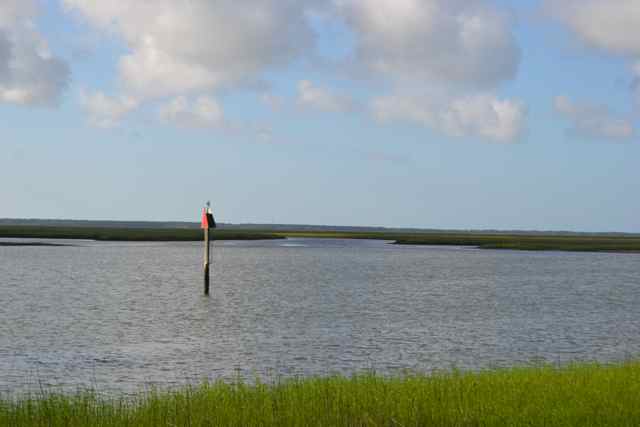 On the first major creek bend, the point was patrolled by a two-foot shark, its dorsal and tail fins slicing the surface and propelling the fish in its search. I shared the creek with no other boats, and near the Shark Hole I passed a sole dolphin.
On the first major creek bend, the point was patrolled by a two-foot shark, its dorsal and tail fins slicing the surface and propelling the fish in its search. I shared the creek with no other boats, and near the Shark Hole I passed a sole dolphin. 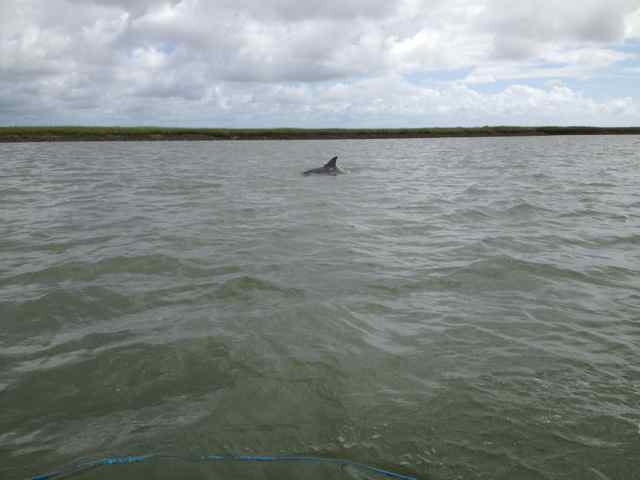 The view toward Bulls Bay was dazzling, and occasionally the surface would explode with the plunge dive of a brown pelican.
The view toward Bulls Bay was dazzling, and occasionally the surface would explode with the plunge dive of a brown pelican.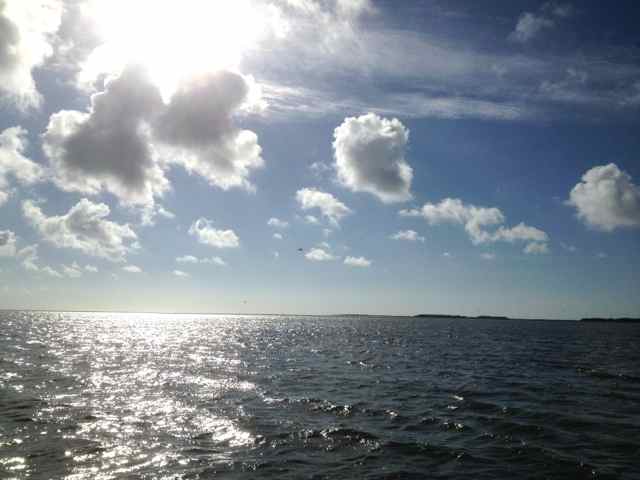
It was one long close hauled starboard tack toward my destination – Bull Inlet. Averting my eyes from the sun, I changed my perspective, viewing downwind. I made out a large round object on the surface as a derelict crab trap, its buoy fouled with dark marine growth. In another minute, a similar sized but different colored object surfaced, and after a breath the loggerhead saw me and dove. Within a minute or two, another loggerhead came up in my field of vision; a dolphin followed.
I continued past the Northeast Point and out into the inlet, selecting the exposed shoal on the southwestern side to land. There was a large expanse of sand to walk around. To the southwest small waves danced, and the Boneyard loomed in the distance. 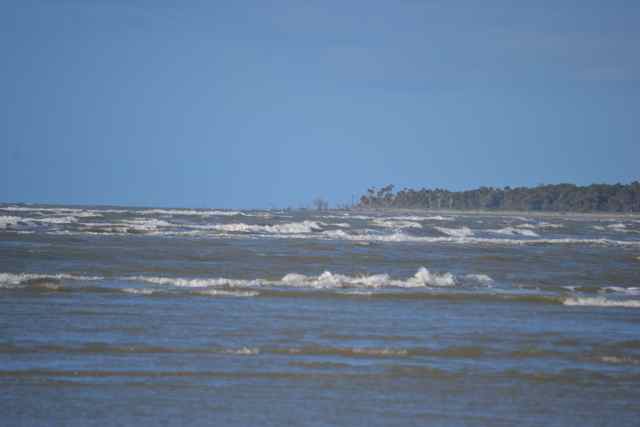 To the southeast a larger area of bigger waves known as Bull Breakers tossed around the waters; several shrimper trawlers worked beyond in the open Atlantic.
To the southeast a larger area of bigger waves known as Bull Breakers tossed around the waters; several shrimper trawlers worked beyond in the open Atlantic. 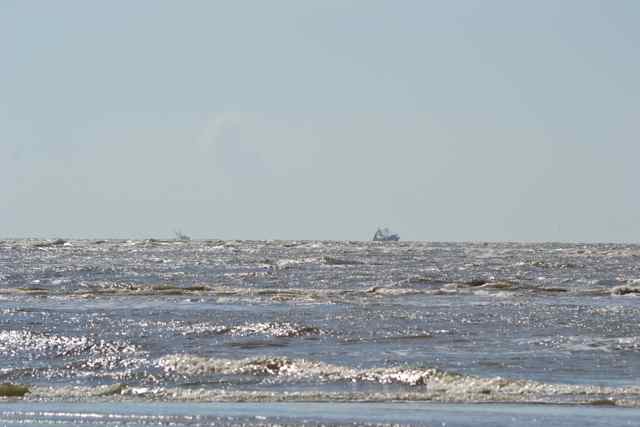
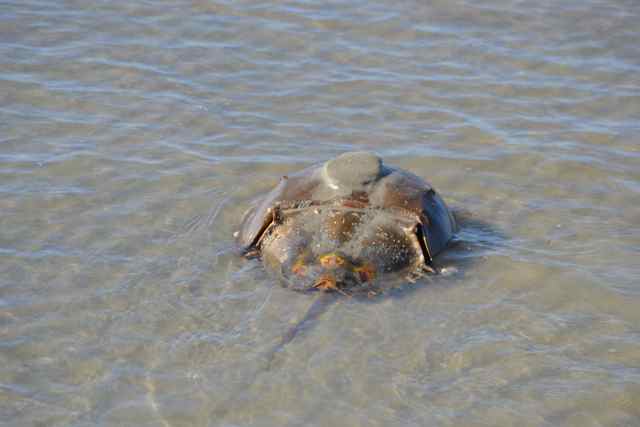 A sole horseshoe crab ambulated in the shallows. The transience of this place was apparent as I explored.
A sole horseshoe crab ambulated in the shallows. The transience of this place was apparent as I explored.
I set sail again, heading across what I thought was the channel toward exposed shoals to the northeast. The water was very shallow, and my daggerboard dragged until I pulled it out. The rudder also found the bottom, but I was able to find deeper water. The shoal ahead was populated by many birds, and I came around to the north side, finding deeper water all the way to an easy landing. Pulling Kingfisher up high and dry, I began my visit to this sandy flat. Royal terns were out in numbers, as they were throughout the refuge for breeding. 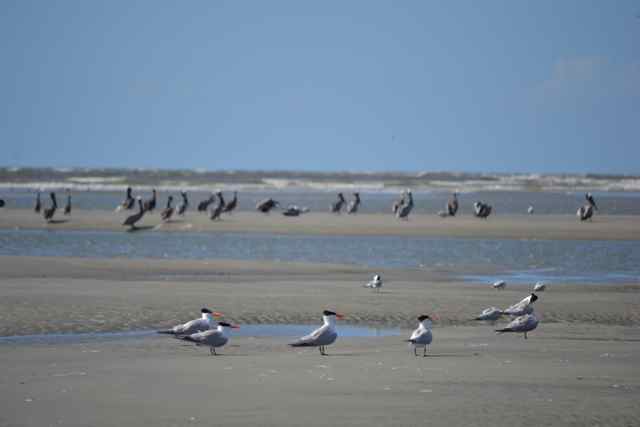
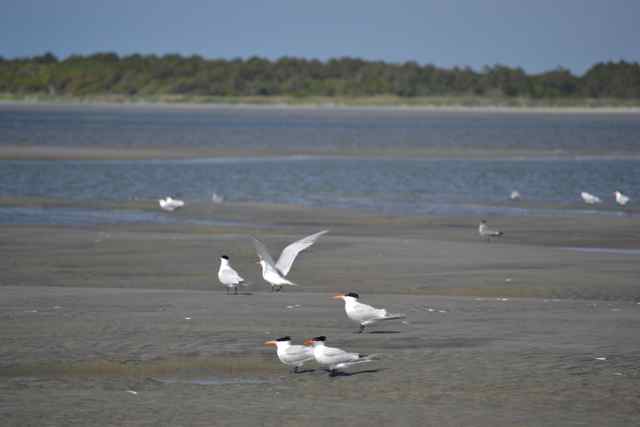 One of their nesting colonies was several miles across the Bay on Marsh Island. Brown pelicans were also out in force, using these ephemeral sands as a roost. A few laughing gulls mixed in, and one robbed a freshly caught fish from a royal.
One of their nesting colonies was several miles across the Bay on Marsh Island. Brown pelicans were also out in force, using these ephemeral sands as a roost. A few laughing gulls mixed in, and one robbed a freshly caught fish from a royal. 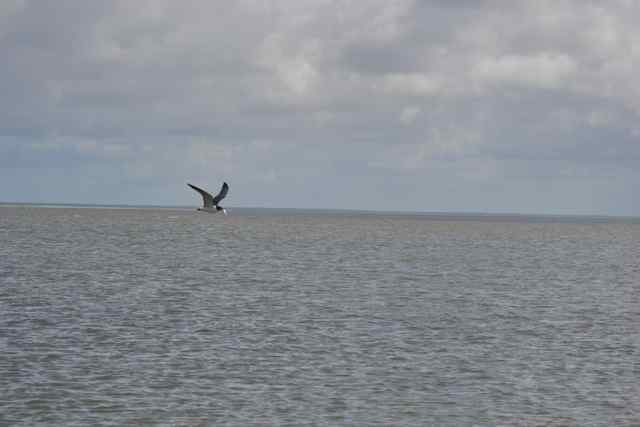 This crime did not go unpunished, for the gull’s attempt to make a meal was thwarted by first one and then several other laughing gulls.
This crime did not go unpunished, for the gull’s attempt to make a meal was thwarted by first one and then several other laughing gulls.
I left this shoal for one more stop – the small sand island about a half mile to the north of the NE point of Bull Island. It is a place I refer to as Skimmer Key – black skimmers have been using it for breeding the past few summers. 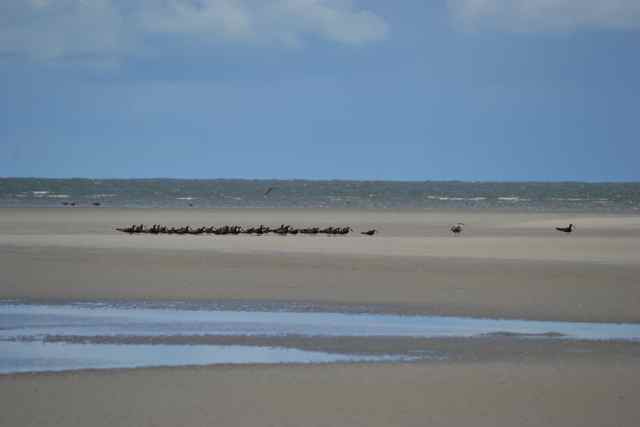
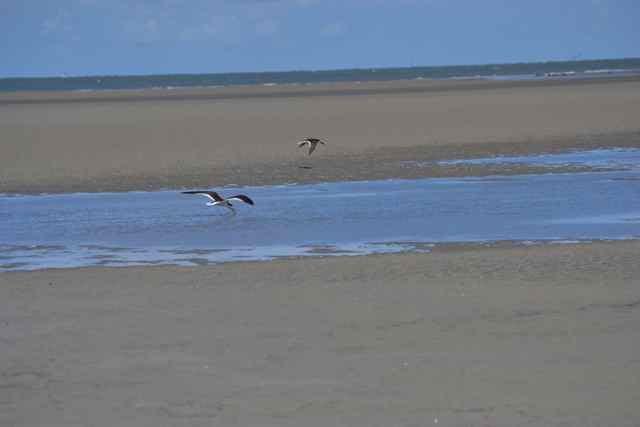 I had watched this island evolve, and was interested to see what were the latest changes. Several years ago the isle had vegetation beginning to colonize the highest points. Yet on this day there was no evidence of any growth. Two years ago Hurricane Irene had raked the isle of the growth, and I was a bit surprised to see no resurgence. The isle was mainly populated by horseshoe crabs, more dead than alive, along with the wreck of an almost thirty-foot fiberglass motor boat.
I had watched this island evolve, and was interested to see what were the latest changes. Several years ago the isle had vegetation beginning to colonize the highest points. Yet on this day there was no evidence of any growth. Two years ago Hurricane Irene had raked the isle of the growth, and I was a bit surprised to see no resurgence. The isle was mainly populated by horseshoe crabs, more dead than alive, along with the wreck of an almost thirty-foot fiberglass motor boat.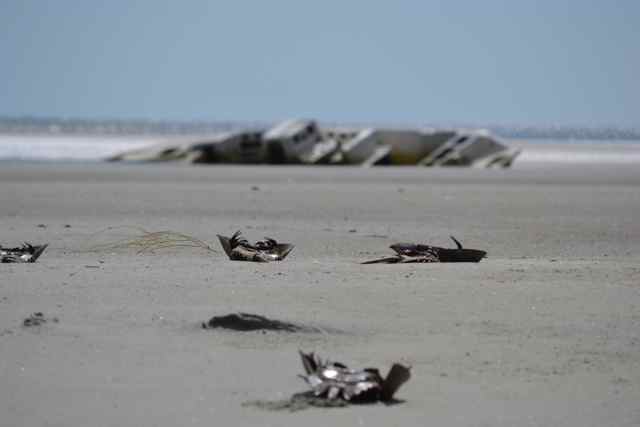
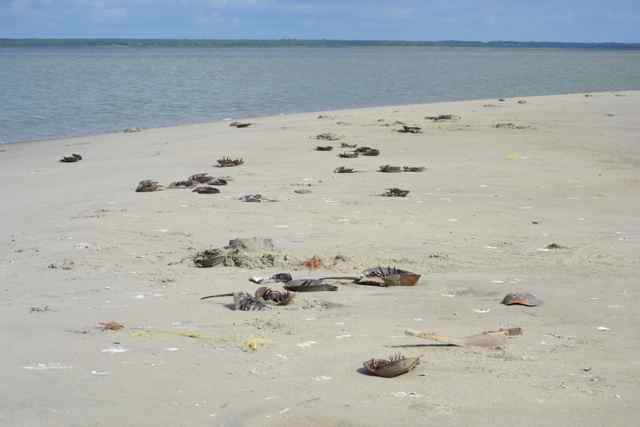 There had been talk in the refuge of removing this derelict, but it appeared from its present situation that it was not going anywhere. There were still some live horseshoe crabs around the key, and they were in survival mode, digging in to bury themselves to weather the sun until the next high tide.
There had been talk in the refuge of removing this derelict, but it appeared from its present situation that it was not going anywhere. There were still some live horseshoe crabs around the key, and they were in survival mode, digging in to bury themselves to weather the sun until the next high tide.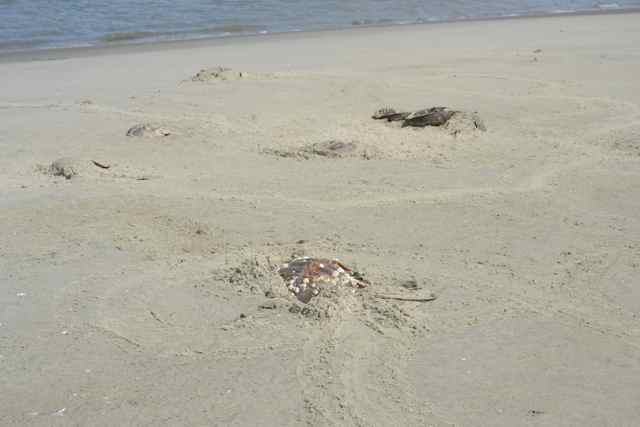
I recall two years ago viewing Skimmer Key soon in May, and seeing numbers of migrating shorebirds feeding on the newly laid horseshoe crab eggs. In the past month Patrick McMillan of the ETV show Expeditions with Patrick McMillan gave two fundraising tours on Bull Island. 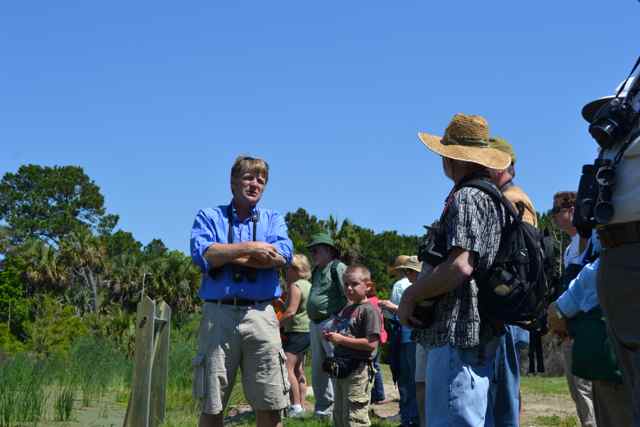 A main point was that Cape Romain National Wildlife Refuge (CRNWR), along with the entire National Wildlife Refuge system, provides necessary habitat, feeding, and breeding grounds for migratory birds – visitors rather than permanent residents. One of his vivid examples is the journey of red knots from their wintering grounds in the Southern Hemisphere toward breeding grounds in the Arctic, a marathon passage fueled in various places but significantly in CRNWR by the eggs of horseshoe crabs. Amazingly, the travels of red knots are timed with a stopover in CRNWR right after the horseshoe crab mating and egg laying on the highest tides during the May full moon. Other CRNWR visitors find fertile grounds for their life cycles, none more prominently than the loggerheads nesting on the beaches of the refuge’s barrier islands.
A main point was that Cape Romain National Wildlife Refuge (CRNWR), along with the entire National Wildlife Refuge system, provides necessary habitat, feeding, and breeding grounds for migratory birds – visitors rather than permanent residents. One of his vivid examples is the journey of red knots from their wintering grounds in the Southern Hemisphere toward breeding grounds in the Arctic, a marathon passage fueled in various places but significantly in CRNWR by the eggs of horseshoe crabs. Amazingly, the travels of red knots are timed with a stopover in CRNWR right after the horseshoe crab mating and egg laying on the highest tides during the May full moon. Other CRNWR visitors find fertile grounds for their life cycles, none more prominently than the loggerheads nesting on the beaches of the refuge’s barrier islands.
McMillan on the safaris also talked about the human visitors to wildlife refuges, and their importance. On that fundraising day loggerhead turtles, an endangered species, got a big financial boost. He advocated that people can participate in ongoing efforts to keep the refuges’ ecosystems, and the wildlife they protect, sustainable. He did not mention a specific group of visitors who have passed through the CRNWR over the years: accomplished naturalists. McMillan follows a long line of this breed that includes Rudy Mancke in recent years, and notably Rachel Carson in the past. Prominent photographers capturing images include local Tom Blagden, and in the past Alan Cruickshank. Many of the visitors to Bull Island have the privilege of being guided by young skilled naturalists of Coastal Expeditions, captains Chris Crolley and Will Christenson leading the way. Historically one of the first naturalists to write about Bull Island was John Lawson in his book A New Voyage to Carolina. His observations were noteworthy, both of the area’s natural history, and of the Sewees, a coastal tribe with great skill in the natural world. Here is a passage from his book on his visit to Bull Island in 1700.
On the Morrow we went and visited the Eastermost Side of this Island, it joining to the Ocean, having very fair sandy Beeches, pav’d with innumerable Sorts of curious pretty Shells, very pleasant to the Eye. Amongst the rest, we sound the Spanish Oyster-Shell, whence come the Pearls. They are very large, and of a different Form from other Oysters; their colour much resembles the Tortoise-Shell, when it is dress’d. There was left by the Tide several strange Species of a muciligmous slimy Substance, though living, and very aptly mov’d at their first Appearance; yet, being left on the dry Sand, (by the Beams of the Sun) soon exhale and vanish.
At our Return to our Quarters, the Indians had kill’d two more Deer, two wild Hogs, and three Racoons, all very lean, except the Racoons. We had great Store of Oysters, Conks, and Clanns, a large Sort of Cockles. These Parts being very well furnish’d with Shell-Fish, Turtle of several Sorts, but few or none of the green, with other Sorts of Salt-water Fish, and in the Season, good Plenty of Fowl, as Curleus, Gulls, Gannets, and Pellicans, besides Duck and Mallard, Geese, Swans, Teal, Widgeon, & c.
Taking leave of Skimmer Key, I observed a loggerhead popping up as I set sail across the Bay for home, and had one more running aground episode. Several boats appeared ahead on my course. Out of the Bay, and running past the Shark Hole in Andersonville Creek, I encountered a pod of dolphins. Letting the sail luff, I took the opportunity to watch these marine mammals. The more I watched, the more dolphins I picked out in this pod, perhaps a dozen. This dolphin welcome* capped off my morning visit to the refuge.
wonderful as always … glad I went all the way to the end or I would have missed the nice clip of the dolphins. THANKS…. G
Yes, you have to get to the end to get that goodie.
You are so … real, Salty One. Thank you for reminding me that there is a time to luff the sails and be … now. I appreciate you …c
Looking for more of the now out there.
What you all do allows people to do that.
Makes me want to desert my desk and go sailing around the islands.
Last time I saw that desk, it was ready to capsize. When that happens, definitely go sailing, Bob.
Very interesting as always.
Those horseshoe crabs may have had their plasma borrowed to be distilled for their special hemoglobin.
Nice video of the dolphin party.!
For an in-depth look at these ancient animals that have been around almost 300 million years, check out Crab Wars: a Tale of Horseshoe Crabs, Bioterrorism, and Human Health by William Sargeant.